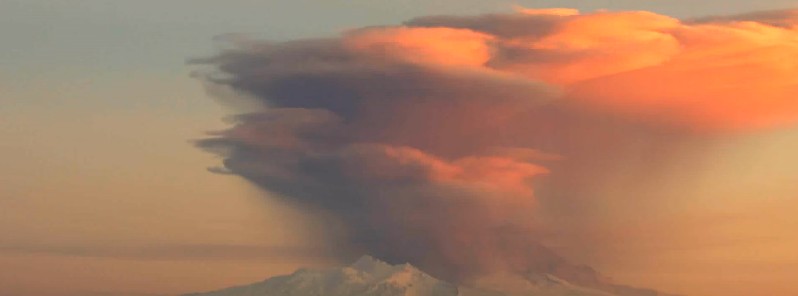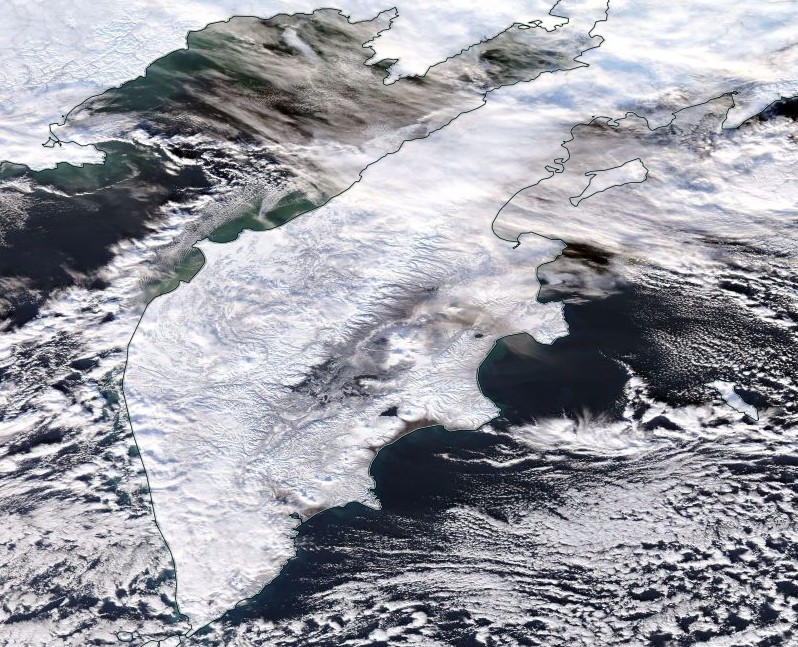Strong eruption at Sheveluch volcano, ash to 10 km (33 000 feet) a.s.l.

After a long period of relative calm, a powerful explosive eruption occurred at Sheveluch volcano, Kamchatka, Russia at 21:00 UTC on December 4, 2017. The eruption lasted about 20 minutes and sent an ash plume to a height of 33 000 feet (10 km) above sea level. The Aviation Color Code remains Orange.
Just 17 minutes after the eruption started, KVERT said video data show an ash plume rising up to 8 – 9 km (26 200 – 29 500 feet) a.s.l. The edge of ash plume/cloud was about 10 km (6.2 miles) NE of the crater.
Satellite imagery acquired 22:40 UTC showed an ash plume extending 127 km (79 miles) to the NE.

Video courtesy KG GS RAS
The eruption caused pyroclastic flows that traveled approximately 1 to 2 km (0.6 – 1.2 miles) down the southwest slope and gave rise to lahars that traveled down up to 3 km (1.8 miles).


Video courtesy La Culture Volcan (imagery via KG GS RAS)
The explosive-extrusive eruption of the volcano continues, KVERT said, adding that ash explosions up to 10 – 15 km (32 800 – 49 000 feet) a.s.l. could occur at any time. Ongoing activity could affect international and low-flying aircraft.


Credit: NASA Aqua/MODIS. Acquired December 5, 2017
Geological summary
The high, isolated massif of Sheveluch volcano (also spelled Shiveluch) rises above the lowlands NNE of the Kliuchevskaya volcano group. The 1 300 km3 (311.9 mi3) volcano is one of Kamchatka's largest and most active volcanic structures. The summit of roughly 65 000-year-old Stary Shiveluch is truncated by a broad 9-km-wide late-Pleistocene (5.6 miles) caldera breached to the south. Many lava domes dot its outer flanks.
The Molodoy Shiveluch lava-dome complex was constructed during the Holocene within the large horseshoe-shaped caldera; Holocene lava dome extrusion also took place on the flanks of Stary Shiveluch.
At least 60 large eruptions have occurred during the Holocene, making it the most vigorous andesitic volcano of the Kuril-Kamchatka arc. Widespread tephra layers from these eruptions have provided valuable time markers for dating volcanic events in Kamchatka. Frequent collapses of dome complexes, most recently in 1964, have produced debris avalanches whose deposits cover much of the floor of the breached caldera. (GVP)
Featured image: Eruption at Sheveluch volcano on December 4, 2017. Credit: KG GS RAS

Commenting rules and guidelines
We value the thoughts and opinions of our readers and welcome healthy discussions on our website. In order to maintain a respectful and positive community, we ask that all commenters follow these rules:
We reserve the right to remove any comments that violate these rules. By commenting on our website, you agree to abide by these guidelines. Thank you for helping to create a positive and welcoming environment for all.